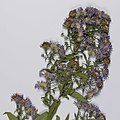Top Qs
Timeline
Chat
Perspective
Symphyotrichum laeve
Species of flowering plant From Wikipedia, the free encyclopedia
Remove ads
Symphyotrichum laeve (formerly Aster laevis) is a flowering plant native to Canada, the United States, and Coahuila (Mexico). It has the common names of smooth blue aster,[5] smooth aster,[4] smooth-leaved aster, glaucous Michaelmas-daisy[6] and glaucous aster.[4]
Remove ads
Description
Smooth aster is 20 to 70 centimeters (8 to 28 inches) tall.[7] Its leaves are arranged alternately on the stems, and their shape varies among lanceolate, oblong-ovate, oblong-obovate, and ovate.[8] They measure from 3 to 20 centimeters (1 to 8 inches) long and from 1 to 2.5 cm (3⁄8 to 1 in) wide. They are usually hairless, and the leaf edges are entire or bluntly or sharply toothed (crenate or serrate), sometimes with smaller teeth (serrulate).[7]
The flower heads are arranged in clusters (panicles). Each flower head has 13 to 23 ray florets with pale to dark blue or purple petals (laminae), and 19 to 33 disc florets that start out yellow and eventually turn purplish-red.[7] The whole flowerhead measures 13 to 25 millimeters (1⁄2 to 1 in) across.[8]
The seeds are cypselae with pappi (bristles at their tips).[7] Like the hairs on dandelion seeds, the pappi allow the seeds to be spread by the wind.[8]
Remove ads
Taxonomy
Summarize
Perspective
There are four varieties: Symphyotrichum laeve var. laeve, S. laeve var. geyeri (Geyer's aster[3]), S. laeve var. concinnum, and S. laeve var. purpuratum.[7]
Hybrids with this species and others of the genus have been reported, including three named as follows:[9]
- Symphyotrichum × gravesii between S. laeve var. laeve and S. dumosum;
- Symphyotrichum × versicolor between S. laeve var. laeve and S. novi-belgii var. novi-belgii; and,
- Symphyotrichum × woldenii between S. laeve var. laeve and S. praealtum, which instead may be between S. oolentangiense and S. praealtum.
- Symphyotrichum × gravesii
- Symphyotrichum × versicolor
- Symphyotrichum × woldenii
Species classifications
-
Symphyotrichum subg. Chapmaniana[ref 1]: 133subg. Astropolium[ref 1]: 133subg. Virgulus[ref 2]: 272subg. Symphyotrichum[ref 2]: 267sect. Conyzopsis[ref 2]: 271sect. Occidentales[ref 2]: 271sect. Turbinelli[ref 1]: 133sect. Symphyotrichum[ref 2]: 268Cladogram references
- Semple, J.C.; Heard, S.B.; Brouillet, L. (2002). "Cultivated and Native Asters of Ontario (Compositae: Astereae)". University of Waterloo Biology Series. 41. Ontario: University of Waterloo: 1–134.
- Nesom, G.L. (September 1994). "Review of the Taxonomy of Aster sensu lato (Asteraceae: Astereae), Emphasizing the New World Species". Phytologia. 77 (3) (published 31 January 1995): 141–297. ISSN 0031-9430. Retrieved 23 August 2021 – via Biodiversity Heritage Library.
- Sugbenus Ascendentes is made up of two allopolyploid species with historic parents from subg. Virgulus and subg. Symphyotrichum.
Remove ads
Distribution and habitat
Symphyotrichum laeve varieties are native to Canada, the United States,[2] and Coahuila (Mexico).[3] The species is introduced in Québec and New Brunswick.[4]
S. laeve grows in fields, open woods, and along roadsides[10] in rocky or dry soil and full sun.[11]
Ecology
Symphyotrichum laeve blooms in late summer and early fall. It is pollinated by many native bees[10] and attracts butterflies.[11] It is a larval host for the pearl crescent butterfly (Phyciodes tharos).[12][8]
Conservation
This section is empty. You can help by adding to it. (July 2025) |
Citations
References
External links
Wikiwand - on
Seamless Wikipedia browsing. On steroids.
Remove ads












